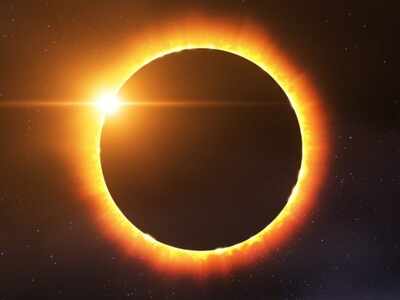Top Searches
- News
- India News
- Nainital-based ARIES of science ministry to organise live telecast of upcoming solar eclipse on social media
Nainital-based ARIES of science ministry to organise live telecast of upcoming solar eclipse on social media

The Nainital-based Aryabhatta Research Institute of Observational Sciences (ARIES) of the Union science & technology ministry will on Sunday organise live telecast of upcoming solar eclipse through YouTube, Facebook and popular digital meeting platform Zoom. India will on Sunday witness annular solar eclipse with the Sun appearing as a necklace of pearls for around 30 seconds during the maximum phase along a narrow corridor running through Rajasthan, Haryana and Uttarakhand.
NEW DELHI: The Nainital-based Aryabhatta Research Institute of Observational Sciences (ARIES) of the Union science & technology ministry will on Sunday organise live telecast of upcoming solar eclipse through YouTube, Facebook and popular digital meeting platform Zoom.
India will on Sunday witness annular solar eclipse with the Sun appearing as a necklace of pearls for around 30 seconds during the maximum phase along a narrow corridor running through Rajasthan, Haryana and Uttarakhand. The eclipse will be partial in the rest of the country.
“Astronomical events such as eclipse are exceptional opportunities to excite and instruct the youth and indeed the society at large about science and to instill scientific temper,” said Ashutosh Sharma, secretary, department of science & technology (DST), as his ministry announced the ARIES’ move to organise live telecast of this phenomena.
A solar eclipse occurs when the moon (at the new moon phase) blocks the solar disk partially or completely, leading to a partial, annular, and total solar eclipse, respectively. An annular solar eclipse (giving appearance of a ring of fire in the sky) occurs when the angular diameter of the Moon falls short of that of the Sun so that it cannot cover up the latter completely. As a result a ring of the Sun’s disk remains visible around the Moon.
The partial eclipse will be visible in India from different places at different timings between 9.56 am (IST) and 2.28 pm (IST) for little over 3 minutes on Sunday. The annular solar eclipse will, on the other hand, be seen at different timings from these places between 11.52 am (IST) and 12.09 pm (IST), ranging from 31 seconds to 45 seconds.
The next annular solar eclipse expected to be visible from India will occur on May 21, 2031, while a total solar eclipse will be seen on March 20, 2034. Total solar eclipses are the rarest of the solar eclipses.
What you need to do and not to do while observing solar eclipse:
Dos:
*Use eclipse glasses (ISO certified) or camera with proper filters attached to watch the eclipse and avoid any damage to the eyes
*Projection on screen using a pinhole camera or telescope is the safest way to watch an annular solar eclipse
*It is ok to eat, drink, take bath, go out during the eclipse.
Don’ts:
*Do not observe the Sun directly by the naked eye
*Do not use X-ray films or normal sunglasses (even with UV protection) to view the eclipse
*Do not use painted glass to see the eclipse
India will on Sunday witness annular solar eclipse with the Sun appearing as a necklace of pearls for around 30 seconds during the maximum phase along a narrow corridor running through Rajasthan, Haryana and Uttarakhand. The eclipse will be partial in the rest of the country.
“Astronomical events such as eclipse are exceptional opportunities to excite and instruct the youth and indeed the society at large about science and to instill scientific temper,” said Ashutosh Sharma, secretary, department of science & technology (DST), as his ministry announced the ARIES’ move to organise live telecast of this phenomena.
A solar eclipse occurs when the moon (at the new moon phase) blocks the solar disk partially or completely, leading to a partial, annular, and total solar eclipse, respectively. An annular solar eclipse (giving appearance of a ring of fire in the sky) occurs when the angular diameter of the Moon falls short of that of the Sun so that it cannot cover up the latter completely. As a result a ring of the Sun’s disk remains visible around the Moon.
The partial eclipse will be visible in India from different places at different timings between 9.56 am (IST) and 2.28 pm (IST) for little over 3 minutes on Sunday. The annular solar eclipse will, on the other hand, be seen at different timings from these places between 11.52 am (IST) and 12.09 pm (IST), ranging from 31 seconds to 45 seconds.
The next annular solar eclipse expected to be visible from India will occur on May 21, 2031, while a total solar eclipse will be seen on March 20, 2034. Total solar eclipses are the rarest of the solar eclipses.
What you need to do and not to do while observing solar eclipse:
Dos:
*Use eclipse glasses (ISO certified) or camera with proper filters attached to watch the eclipse and avoid any damage to the eyes
*Projection on screen using a pinhole camera or telescope is the safest way to watch an annular solar eclipse
*It is ok to eat, drink, take bath, go out during the eclipse.
Don’ts:
*Do not observe the Sun directly by the naked eye
*Do not use X-ray films or normal sunglasses (even with UV protection) to view the eclipse
*Do not use painted glass to see the eclipse
FacebookTwitterLinkedinMail
Start a Conversation
end of article
Trending Topics
Quick Links
Coronavirus in MumbaiCoronavirus in KolkataCoronavirus in HyderabadCoronavirus in DelhiCoronavirus in BangaloreCoronavirus symptomsCoronavirus in IndiaWhat is CoronavirusCoronavirus NewsSolar EclipseNPRWhat is NRCCAB BillCAB and NRCRTI BillPodcast newsLok SabhaShiv SenaYSRCPCongressBJP newsUIDAIIndian ArmyISRO newsSupreme Court